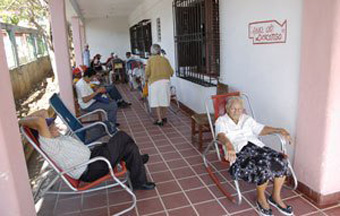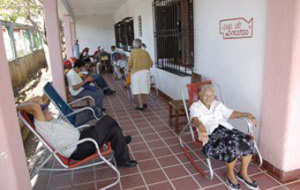CUBA, EL SORPRENDENTE RETO DE UN PAÍS ENVEJECIDO.
El precipitado envejecimiento poblacional de Cuba desafía su futuro con la misma urgencia que la crisis económica o el cambio climático y apremia políticas que lidien con el inédito reto de ser un país muy avejentado y subdesarrollado.
Los datos del fenómeno son contundentes desde hace años: la población decrece, la fecundidad es baja, la esperanza de vida elevada (78 años) y el saldo migratorio externo resulta negativo.
Actualmente, el 18,3% de los 11,1 millones de habitantes de la isla caribeña tiene más de 60 años, pero en 2030 la cifra ascenderá al 30% y Cuba podría ser el país más envejecido de América.
Un estudio realizado por la Oficina Nacional de Estadísticas (ONE) a partir del último censo de población reveló que entre 1953 y 2012 las personas con 60 años o más se multiplicaron por cuatro en la isla, una situación no vista hasta ahora “en ningún país del mundo”.
“El envejecimiento demográfico que presenta Cuba en términos estadísticos solo es comparable con los países más desarrollados”, pero se produjo “en menos de 50 años” mientras que en los países europeos tomó unos dos siglos, señala esa investigación.
En octubre el Consejo de Ministros anunció la aprobación de una nueva política demográfica que estimulará la fecundidad y favorecerá la atención de las personas mayores, aunque aún no se divulgaron detalles.
En los últimos años se han tomando algunas medidas: el Gobierno extendió la edad de retiro, aumentó las pensiones (siguen siendo muy bajas en un país donde el salario medio ronda los 20 dólares mensuales) y permitió la reincorporación de jubilados a sectores como la Educación.
Pero el desafío es enorme para un país con dificultades crónicas -transporte público, vivienda, deterioro de infraestructuras, escasez de productos, alto precio de los alimentos- que multiplicarán su impacto a largo plazo en una sociedad envejecida.
“Nos faltan cosas fundamentales como pañales desechables para adultos, sillas de ruedas y sanitarias, colchones antiescaras, geriatras, personas e instituciones cuidadoras, porque hay pocas y las mejores son de la Iglesia”, subrayó Suárez.
Este año el Estado aumentó el presupuesto para garantizar esas ayudas “técnicas” mediante sus instituciones, y reparar e incrementar los hogares de ancianos y centros diurnos, aunque las listas de espera son largas y el gobierno reconoce que queda mucho por hacer.
Datos del ministerio de Salud Pública indican, por ejemplo, que de los más de 83.000 médicos existentes en Cuba en 2013, solo 279, un 0,33 %, eran especialistas en Geriatría y Gerontología.
La coordinadora del Programa de la Tercera Edad de Cáritas en Cuba, Migdalia Dopico, dijo a Efe que la articulación de un sistema “adecuado” de protección y cuidados debe ser prioridad y, en particular, la formación de cuidadores.
En el caso de Cáritas, más de 3.000 voluntarios atienden en las comunidades del país a unas 28.000 personas, con servicios de comida, lavado de ropa o talleres que han optado por incorporar el adiestramiento de cuidadores y las “relaciones intergeneracionales”.
“La Iglesia tiene pocos hogares de ancianos y muy demandados”, señaló Dopico, y aunque en la sociedad cubana existen prejuicios culturales para “institucionalizar” a los ancianos, la experta afirma que “se notan más peticiones” y la tendencia es al alza.
El censo de 2012 arrojó que en un 9% de los hogares cubanos conviven al menos tres generaciones, mientras que en el 12,6% residen ancianos solos.
En otra investigación concluida en 2011, un 71% de los ancianos entrevistados afirmó que su único ingreso era la pensión, un 15% dijo tener ayuda de familiares “en Cuba o en el exterior”, mientas que un 60% admitió vivir con “privaciones y carencias”.
EconomiaHoy, Mexico/EFE/Excerpts/InternetPhotos/www.thecubanhistory.com
The CUban History, Hollywood
Arnoldo Varona, Editor.
CUBA, THE STRIKING CHALLENGE OF AN AGING COUNTRY.
The precipitate aging of the Cuba population challenges its future with the same urgency as the economic crisis or climate change and urges policies to grapple with the unprecedented challenge of being a very old-looking and underdeveloped country.
The details are striking phenomenon for years: population decreases, fertility is low, high life expectancy (78 years) and external migration balance is negative.
Currently, 18.3% of the 11.1 million inhabitants of the Caribbean island has more than 60 years, but in 2030 the figure will rise to 30% and Cuba could be the oldest population in America.
A study by the National Statistics Office (NSO) since the last census revealed that between 1953 and 2012 people aged 60 and over increased fourfold in the island, a situation not seen before “in any country the world. ”
“The aging population presents Cuba in statistical terms is only comparable to the most developed countries,” but there was “less than 50 years” while European countries took about two centuries, states that investigation.
In October the Council of Ministers announced the approval of a new population policy that will stimulate fertility and promote care of the elderly, but still no details were disclosed.
In recent years there have been taking some steps: the government extended the retirement age, increased pensions (still very low in a country where the average monthly wage is around $ 20) and allowed the return of retirees to sectors such as Education .
But the challenge is huge for a country with chronic difficulties public-transportation, housing, deteriorating infrastructure, product shortages, high prices of food-that multiply their impact in the long term in an aging society.
“We lack basic things like sanitary disposable adult diapers, wheelchairs and decubitus mattresses, geriatricians, people and carers institutions, because there are few, and the best are of the Church,” said Suarez.
This year the government increased the budget to ensure these “technical” aid through its institutions, and repair and increase nursing homes and day centers, but the waiting lists are long and the government recognizes that more needs to be done.
Data from the Ministry of Public Health indicate, for example, that of the more than 83,000 doctors in Cuba in 2013, only 279, 0.33% were specialists in geriatrics and gerontology.
The Program Coordinator Senior Caritas in Cuba, Migdalia Dopico, told Efe that the articulation of an “adequate” protection and care system should be a priority and in particular, the formation of caregivers.
For Caritas, over 3,000 volunteers serving in communities across the country to some 28,000 people, with food services, laundry or workshops that have chosen to incorporate the training of caregivers and “intergenerational relations.”
“The Church has few nursing homes and in high demand,” said Dopico, although in Cuban society there are cultural prejudices to “institutionalize” the elderly, the expert states that “more requests noticeable” and the trend is upward.
The 2012 census showed that 9% of Cuban households live at least three generations, while 12.6% live alone elderly.
In another study concluded in 2011, 71% of older respondents stated that his only income was the pension, 15% said they had help from family “in Cuba or abroad,” lie that 60% admitted to live with “deprivation and shortcomings “.
EconomiaHoy, Mexico / EFE/Excerpts / InternetPhotos / www.thecubanhistory.com
The Cuban History, Hollywood
Arnoldo Varona, Editor



 CUBA, the striking challenge of an aging country. ** CUBA, el sorprendente reto de un país envejecido.
CUBA, the striking challenge of an aging country. ** CUBA, el sorprendente reto de un país envejecido.



